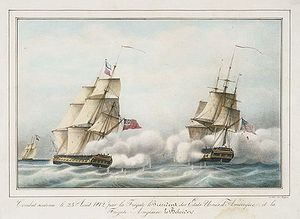HMS Belvidera (1809)
 Battle between HMS Belvidera and USS President on 23 August 1812 | |
| Career (United Kingdom) | |
|---|---|
| Name: | HMS Belvidera |
| Ordered: | 28 September 1808 |
| Builder: | Deptford Dockyard |
| Laid down: | December 1808 |
| Launched: | 23 December 1809 |
| Fate: |
Receiving ship, Portsmouth, 1860 Sold for breaking, 1906 |
| General characteristics | |
| Type: | Apollo-class fifth-rate frigate |
| Tons burthen: | 943 53/94 (as designed) |
| Length: |
145 ft (44 m) (gundeck) 121 ft 9.375 in (37.11893 m) (gundeck) |
| Beam: | 38 ft 2 in (11.63 m) |
| Draught: | 13 ft 3 in (4.04 m) |
| Propulsion: | Sail |
| Sail plan: | Full-rigged ship |
| Complement: | 264 |
| Armament: |
Rated at 36 guns:
|
HMS Belvidera was a 36-gun Royal Navy Apollo-class fifth-rate[a] frigate built in Deptford in 1809. She saw action in the Napoleonic Wars and the War of 1812 and continued a busy career at sea into the middle of the 19th century. In 1846 she was reduced to harbour service, in 1860 she became a receiving ship, and she was finally disposed of in 1906.
Contents
Service
On 22 July 1810, Belvidera, Captain Richard Byron, and Nemesis, Captain William Ferris, were standing close in-shore of Studtland, Norway. They sighted three Danish gun-vessels. Two of them, Bolder and Thor, commanded by Lieutenants Dahlreup and Rasmusen, were schooner-rigged. Each mounted two long 24-pounders and six 6-pounder howitzers and had a crew of 45 men. The third gun-vessel was of a smaller class, and carried one long 24-pounder with 25 men. The next day, the boats of Belvidera and Nemesis cut out the two larger vessels. The British suffered no casualties, though the Danes lost four men killed. The remaining vessel, gun-boat No. 5, ran up a creek where her crew abandoned her; the British then burnt her.[1]
In 1811, Belvidera became the flagship of Admiral Herbert Sawyer on the Halifax station.
Belvidera and the USS Constitution
The Belvidera took part in one of the earliest actions of the War of 1812 when she encountered the American heavy frigates USS President, the USS Congress and the USS United States on 23 June 1812, five days after the war had started. The British were not aware that war had been declared and after returning fire they managed to evade their pursuers during the night. The Belvidera's course during the fight had led the Americans away from a British convoy from Jamaica, allowing the convoy to escape attack.
On 16 July 1812, Belvidera was part of a British squadron that gave chase to the USS Constitution, another of the United States' heavy frigates, which was on her way from Chesapeake Bay to New York. In the very light winds, both sides put out boats to tow the ships. The Constitution gained an advantage by using her anchors to pull herself about four miles ahead of the Belvidera. Captain Byron then copied the manoeuvre of the Constitution and managed to bring the two ships within gunshot. They exchanged fire as a light breeze came up, and by daylight on July 19 the Constitution, being newly out of port, was able to escape.
Prize-taking
For the remainder of the war, Belvidera was active in the blockade of the American coast, capturing many American merchant ships and privateers. On 21 August she captured the U.S. privateer 7-gun schooner Bunker's Hill, with 72 men. On 8 February 1813, boats of Maidstone, Belvidera, Junon and Statira, which were at anchor in Lynhaven Bay, chased and captured the schooner Lottery, of 225 tons, and pierced for 16 guns. The British took her into service as the 10-gun schooner Canso. On 2 April 1814, Belvidera captured the US 6-gun New Zealander, of 256 tons, with 17 men, and laden with spermaceti oil. New Zealander, a prize to the USS Essex, had departed Valparaiso for the United States. Then on 19 June Belvidera captured the American schooner Nancy and Polly. Three days later she captured the sloop Alonzo. The next day she captured the sloop Hunter, of 60 tons and nine men, bound to New York with a cargo of tar and turpentine.
Post-war
At the end of 1814, Belvidera was decommissioned at Portsmouth. She was relaunched on 26 September 1817, having been refitted. She made numerous cruises to the Mediterranean, Portgual, Madeira, and the West Indies. In 1834 she took troops to St Kitts and then on a second trip, to Trinidad. On 17 May 1835 she was reported to be at Puerto Rico, where she was attempting to recover either escaped slaves, or slaves that had been improperly sold.
By 1846 she was on harbour service, and by 20 December 1848, she was at Portsmouth.
Fate
She became a receiving ship at Portsmouth by 1860. As late as 1890 she was still a receiving ship. She was disposed of in 1906.
Notes
a. ^ See rating system of the Royal Navy.
References
- ↑ James (1837), Vol. 5, pp.231-2.
- James, William (1837), The Naval History of Great Britain, from the Declaration of War by France in 1793, to the Accession of George IV., 5, R. Bentley
- Winfield, Rif (2008), British Warships in the Age of Sail 1793–1817: Design, Construction, Careers and Fates, Seaforth, ISBN 1861762461
